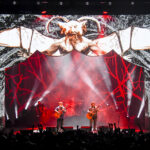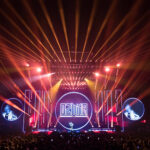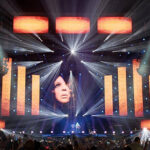
A Look at GM’s Booths, Lit by Nautilus Entertainment Design
Detroit has hosted an auto show since 1907, becoming the North American International Auto Show (NAIAS), a truly international event, 31 years ago. One of the most influential annual automotive events in the world for the industry, NAIAS serves as a global stage for companies to debut vehicles and make industry-shaping announcements. The attention required for every detail of their booths is a top priority to the automotive brands on the floor to effectively display the cars and the brands themselves.
This year’s NAIAS events kicked off with press previews on Jan. 14 and 15, with the public show running from then until Jan. 27. The booth builds themselves start in late fall each year, continuing through to the opening.

The Lighting Team for the GM Brands
Having lit many press previews and automaker’s booths over the years at NAIAS, Nautilus Entertainment Design (NED) lit four of the booths for General Motors’ brands at the 2019 show — Cadillac, Chevrolet, GMC and Buick. This year’s NED team included lighting designers, Jim Tetlow, Ashley Kidwell, Logan Hayden, Tyler Lambert-Perkins and Kurt Doemelt.
The NED designers are brought in by Light Source Inc., located in Detroit. Light Source is the lighting team that supplies all the equipment and the crews. The Chicago-based Czarnowski is the exhibit designer and has been working with GM for the past nine years. “We’ve got a rapport, a good working relationship all the way around; good communication with all of them,” says Tetlow. NED has been lighting GM brand booths at auto shows for 14 years.
“We lit all four different GM brands’ exhibits on the floor with all the cars,” explains Tetlow. “That exhibit lighting was handled by Ashley and two other onsite LDs. There was also a two-story structure within the Cadillac booth that contains a series of offices on both floors, a reception area and secondary exhibits that Kurt designed. These secondary areas are designed with architectural lighting, truly architectural lighting like many of the projects that we do with recessed fixtures. In parts of the office spaces were also displays of artwork and other cars, like a 1950s Cadillac Eldorado. In the main booth exhibits is where we used the production gear.”
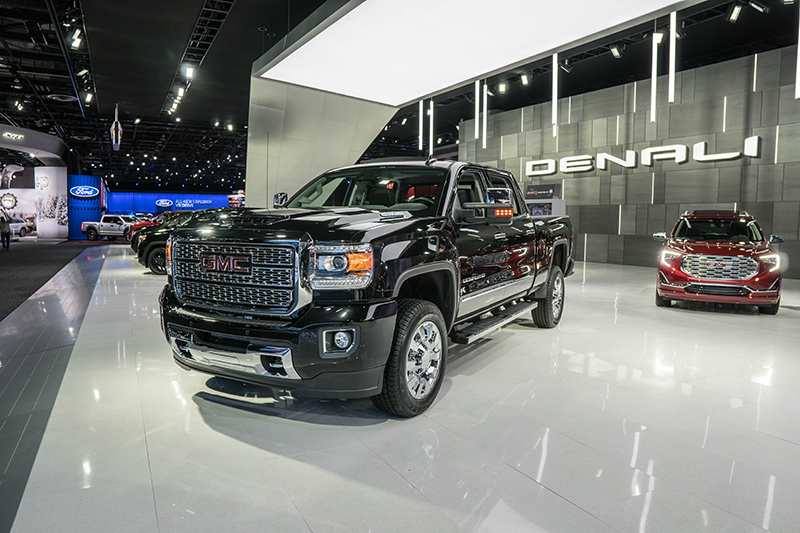
Drawing an Audience
This year, the Cadillac booth had a new design, mostly with expanded use of movable LED walls along with a new lighting design, “I think more so on this particular exhibit, than we’ve had the last few years, there’s definitely a bigger technological integration in the exhibit,” explains Kidwell. “There are moving video walls that have all of content elements—brand videos, sizzle reels for particular cars, etc. We’ve basically supplemented those videos and those moments with the lighting package. When they’re doing a vehicle reveal, or they’re about to go into a vehicle presentation, they play the reel for that particular car and we use lighting to draw attention to that car. We’re doing a little bit of a razzle dazzle club feel in the booth to get everybody interested and intrigued, pulled into the booth—here’s the car that you’re going to be presented over the course of the next 10 minutes. ‘Everybody, come look at what’s flashing’; that draws them into what’s going to happen next.”
Tetlow adds, “That’s really been emphasized with this particular booth design. It’s ‘come into this booth and look at this product’. That’s what we’ve really been supporting with the lighting design.” The video walls are automated to be moved to the side of the booth where the car that’s being showcased is parked. “Basically, all the technology in the booth spills down to that particular product being highlighted,” says Tetlow. The video walls in the exhibit were fed content via Dataton’s Watchout media server.
Event Partners produced the Cadillac booth at the 2019 show with Czarnowski designing the exhibit. The video walls were provided by Bluewater Technologies and the rigging and technical services for the video walls automation was provided by Vegas Rigg.
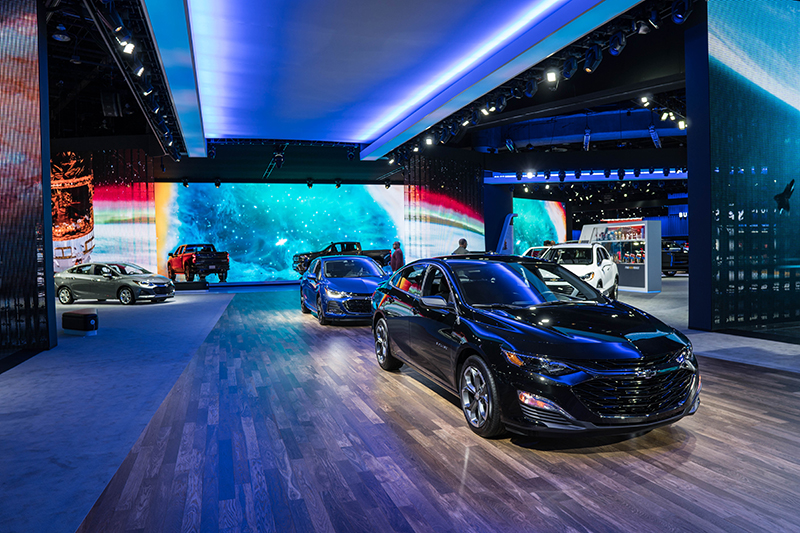
Texture and Color
When lighting the automobiles being presented, the team sticks with the basics to illuminate the cars. “The cars themselves are lit with all white light; daylight white light,” says Tetlow. Kidwell notes though the cars are lit individually with daylight white, they “do have a package so that we are basically toning the entire Cadillac booth in color to support the colors in the video content.”
There are times when the designers do want to add a touch of color to help make a car pop visually. “There are some circumstances where we like to add a bit of CTO,” comments Kidwell. “In that situation, having a gel frame so we can add that color is great. We add an eighth CTO and it just gives that kiss of orange to some of the red or orange cars.”
For the Cadillac booth, most of the cars are being lit with Chroma-Q’s AutoLED II LED-based luminaires that produce 5,500K CCT daylight white. With an output of over 16,000 lumens, the lights give enough punch to cut through other lighting in the booth to make the cars really stand-out. By using an LED-sourced automated light, the design team has a lot of lighting options as well as the benefits of saving time, power and labor versus the old, fixed metal halide lights used to light cars in the past. The automobiles in the presentations are also being lit with Philips Vari-Lite VL3500s and Claypaky Sharpy Washes.
“This method and the use of the Chroma-Q AutoLED units are similar across all four GM brands,” says Kidwell. “Other than Cadillac, we’re using a combination of both AutoLED I and IIs. But for all of the brands—all of the hero cars and the cars on turntables, we light with Sharpy Washes or VL3500 Spots depending on the car and the location of the car in the booth.”
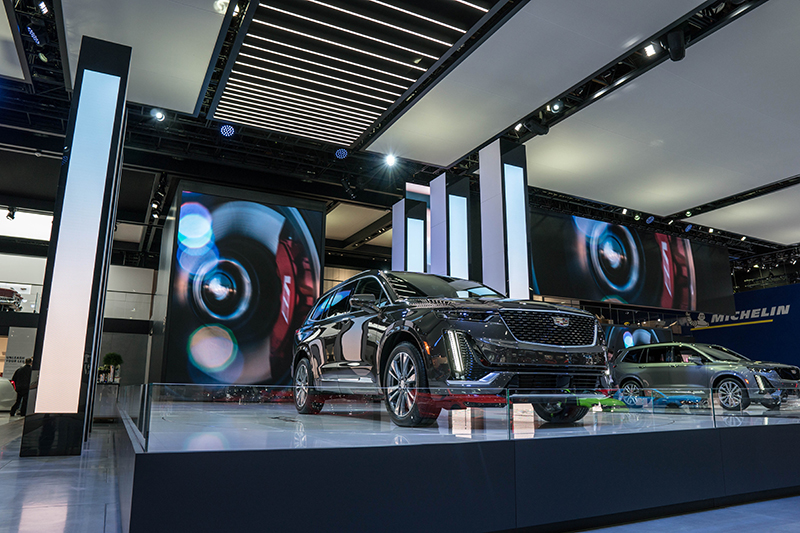
Counterintuitive Pop
When it comes to lighting the main, hero cars that are being highlighted, the NED team turns to those key automated lighting choices to solve their challenges. “Our big workhorse is still VL3500 Spots,” explains Kidwell. “Then we started using the Sharpy Washes on cars because of the punch of color that we get on the cars. We have the ability to dial in a little bit of red, or magenta, or blue on any one of the hero cars; really make it pop. It’s really nice with the Sharpy Wash.”
It would seem counterintuitive to most people that the lighting team use Sharpy Washes in this manner. “We’re using Sharpy Washes at short distances, but with maximum diffusion and beam shapers,” says Tetlow. “It’s really about purity of color, punch and those sorts of qualities. You think of a Sharpy Wash as a long throw, beamy fixture with a very tight beam, which of course, it excels at. It’s even great for lighting cars at 60 to 70-feet as well, but we’re using them 24-feet away with all the diffusion and beam-shaping you can put in there and still have that beamy, punchy quality with just gorgeous color.” Kidwell adds, “For me personally, I like using the Sharpy Wash because they just have a certain sparkle quality to them that really makes the chrome accents and metallic flake in the car paint colors shine.”
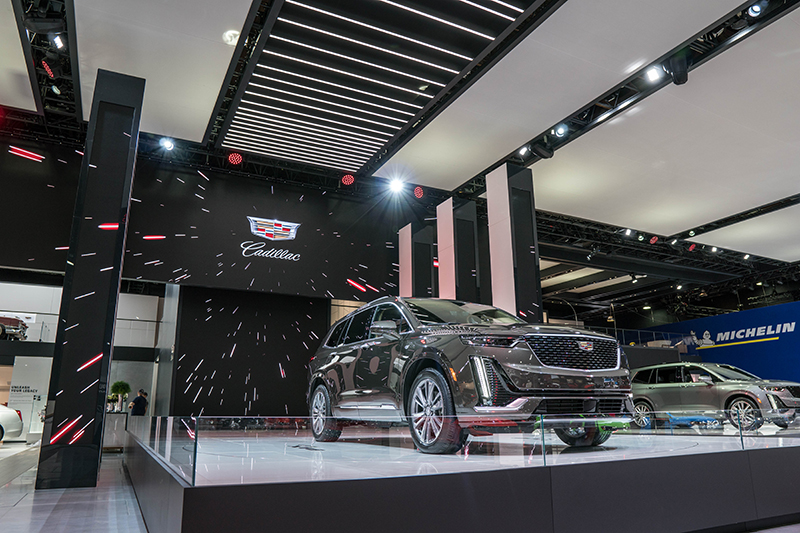
Evolving Technology
NED has seen the exhibit lighting evolve over the years. “Going back 14 years ago, we were primarily lighting vehicles and most of the exhibits, for that matter, with 575-watt PowerPARs, metal halide lamps, manually focused, not a lot of maintenance, and then supplementing with an automated lighting package for vehicles on turntables, or special effects, or atmospheric lighting; for texture or color,” Tetlow comments. “Now it’s reversed where we really have very few static PowerPARs, and if we do, they’re just focused straight down with super wide lenses for ambient lighting and all the cars are lit with automated lighting.”
Tetlow and the NED team has been using LEDs to light auto show exhibits for the past seven years, primarily with the Chroma-Q AutoLED units that have been improved from version I to II. “Version IIs are absolutely better than version I,” Tetlow comments. “They’re smaller, have more output and I feel like their color temperature is truer. They’re specs have them at 5,500K. They’re very punchy, and they’re small; so, it’s definitely an improvement from what they were seven years ago when we started using them. They put out the same amount of light as a narrow PowerPAR. With their pan and tilt, our team and the Light Source crew can go around and focus everything with iPads. It’s a super-efficient way to do everything. The AutoLEDs currently don’t have a zoom, which we hope to see in the next version. There may be a product coming to market that meets the needs; it’s such a specialized set of requirements. I think that the next generation is going to have these key capabilities to make it even that much more efficient.”
The AutoLED luminaire was specified, and is maintained, by Light Source. “We had some discussion about what an LED automated fixture out to be specifically for the auto lighting and exhibit lighting market,” Tetlow says. “They contracted for a large quantity of the units. Light Source supplies all the gear—the cabling, truss, motors, crews and everything else.” Principal and account executive for Light Source, Inc. was Rick O’Neill; master electrician for Light Source was Jeff Bertuch. Jonny Tosarello programmed the Cadillac booth and David Hauss programmed the Chevrolet booth.
Four Brands; Four Looks
Tetlow and Kidwell note there are definite differences between the designs of the four GM brands at this year’s NAIAS. “I wouldn’t say that the lighting of cars is similar amongst all the booths, using Chevrolet as an example, there’s a lot of color and movement—other than the white lighting on the cars—that’s synchronized with the video,” explains Kidwell. “With Chevy, it’s almost a rave sort of feeling at certain moments with the video content.” Tetlow adds that “then in GMC and Buick, it’s more static lighting, it’s much more traditional. With the design for Cadillac, we didn’t want it to be like Chevy, but we wanted to still have a sense of color and movement to attract people and have a dynamic feel to the booth. I think we did that for Cadillac, without going in the direction of the design for Chevrolet.”
Once again, the NED team has delivered four outstanding lighting designs for the four GM brands that are subtly linked, yet different. The attendees at this year’s NAIAS certainly got to admire the new models from General Motors in just the right light.
